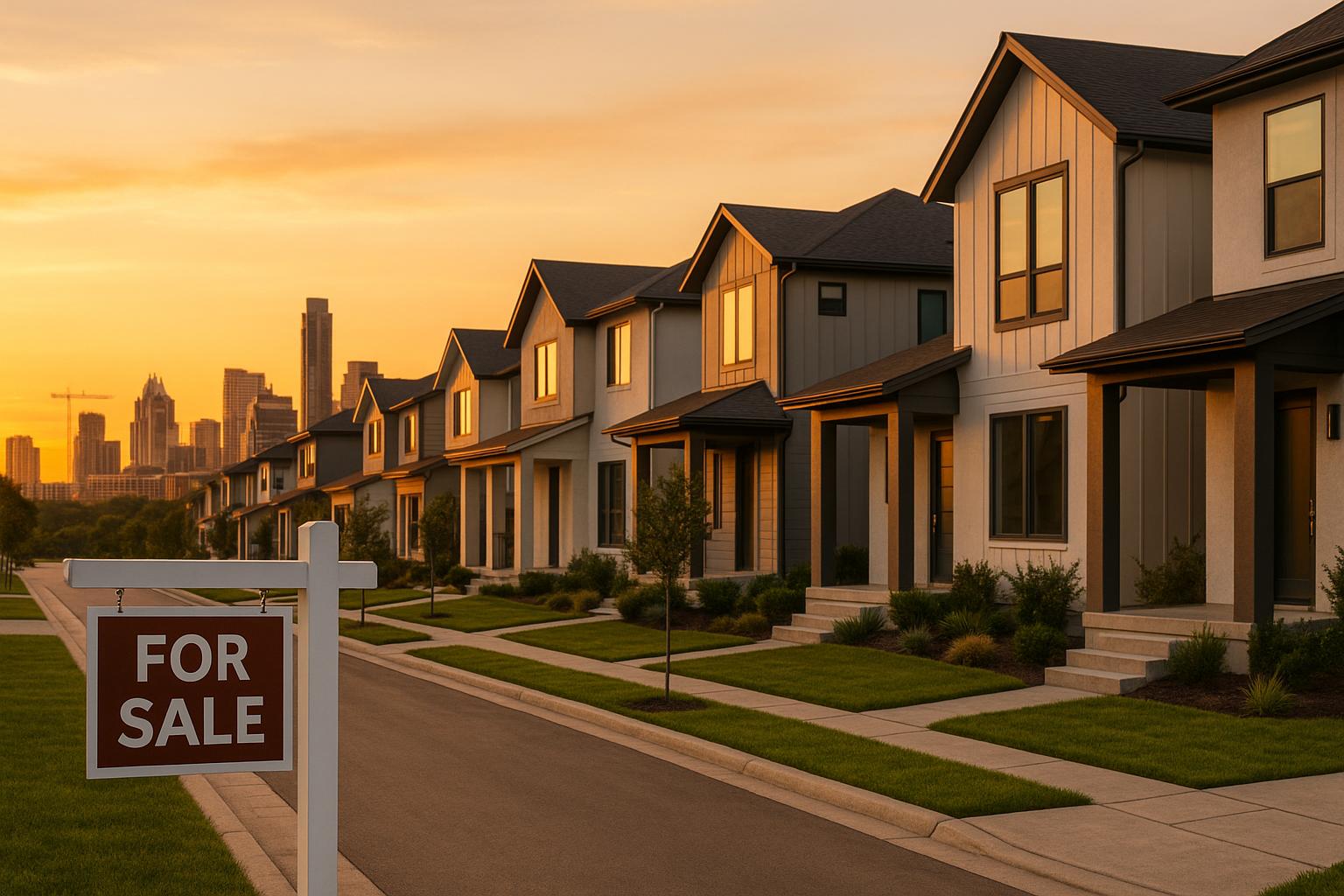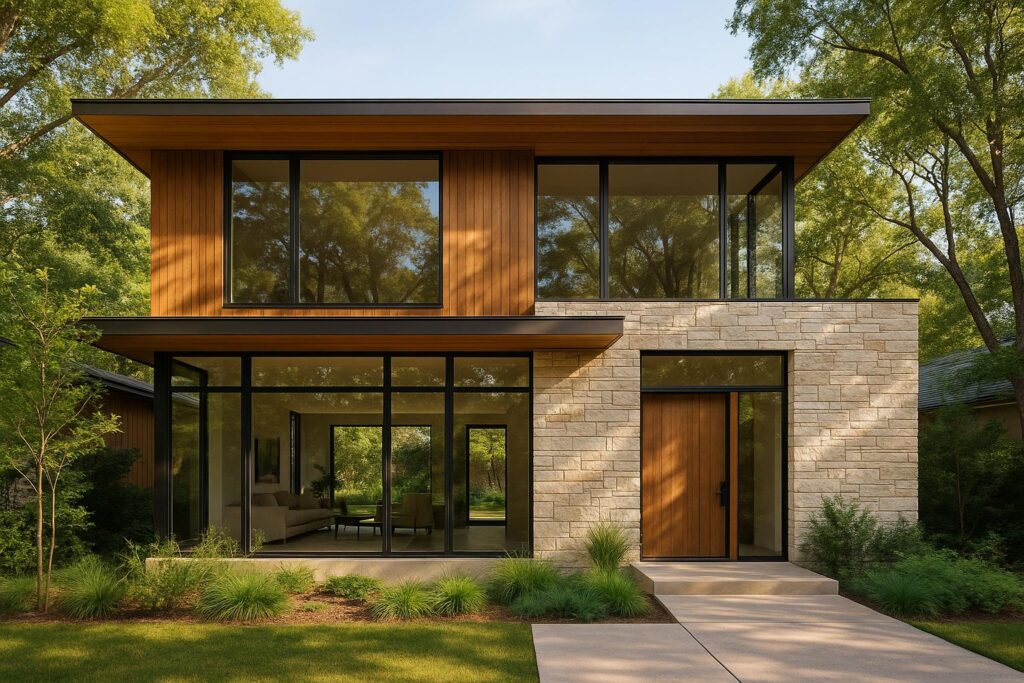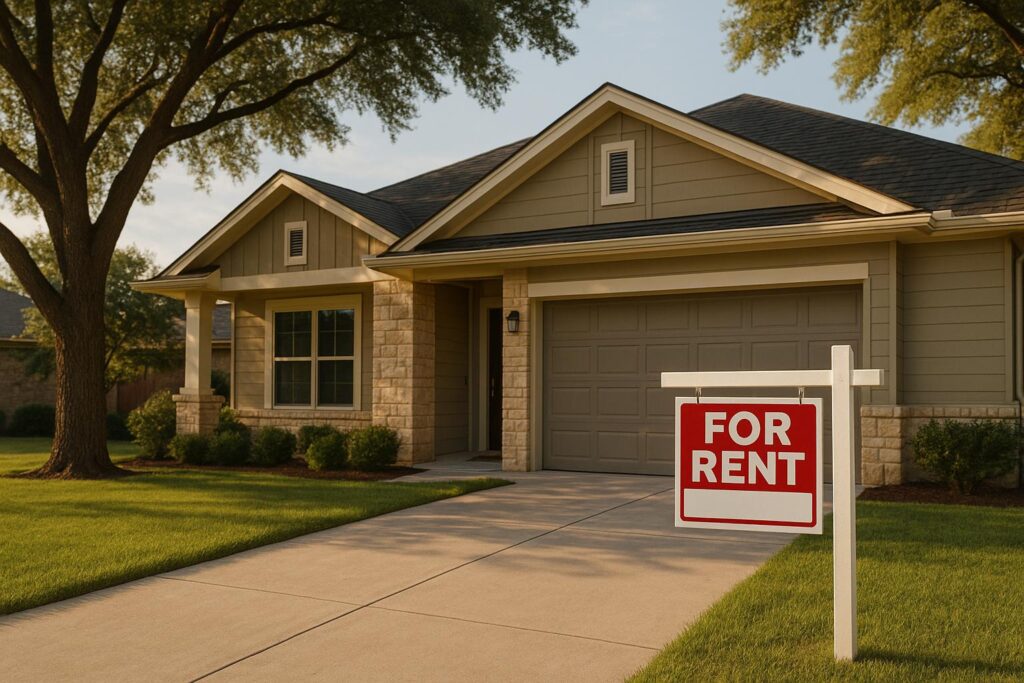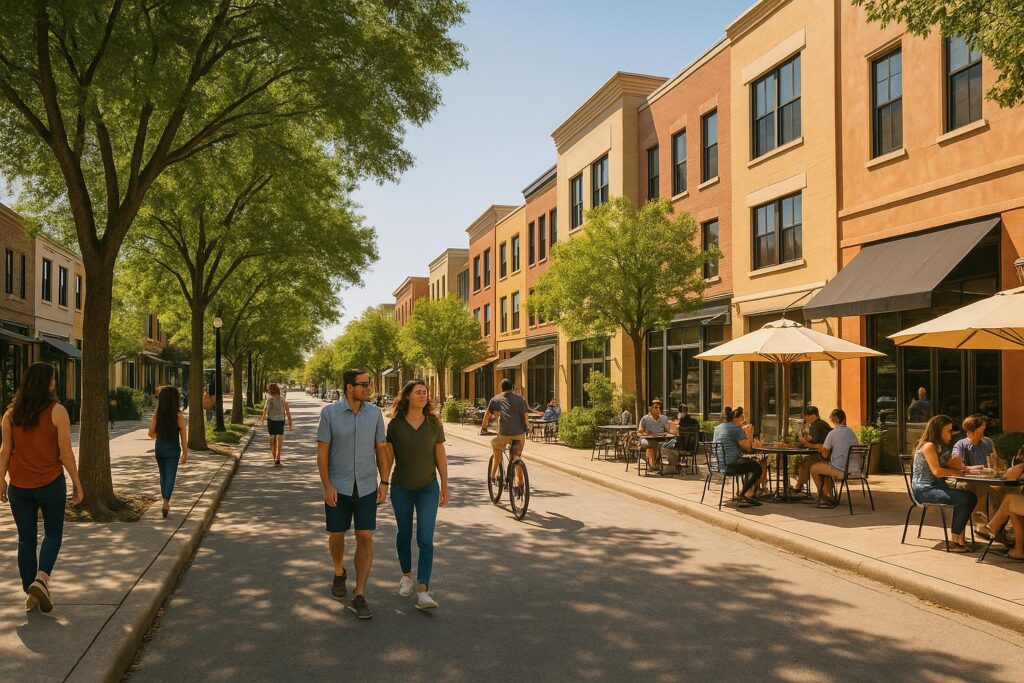Austin’s housing market is shifting toward a buyer-friendly environment. Here’s what you need to know:
- Median Home Price: $450,000 as of April 2025, down 3.2% year-over-year.
- Active Listings: Surged 21% year-over-year to 15,796 in April, with 50.69% of listings seeing price reductions.
- Days on Market: Homes now take an average of 76 days to sell, up from 32 days in 2021.
- Inventory Levels: Monthly inventory climbed to 6.03 months, tipping the market toward buyers.
- Cost Per Square Foot: Median price is $336, up 3.5% year-over-year, with wide price variations by neighborhood.
- FHA Loan Challenges: Delinquencies rose to 11.3%, with 64% of borrowers carrying high debt-to-income ratios.
- New Construction: Builder activity is slowing, with 34% of builders reducing prices.
Quick Comparison Table
| Indicator | 2025 Data | Trend |
|---|---|---|
| Median Home Price | $450,000 | ↓ 3.2% YoY |
| Active Listings | 15,796 | ↑ 21% YoY |
| Days on Market | 76 days | ↑ Slower sales |
| Inventory | 6.03 months | ↑ Buyer’s market |
| Cost Per Square Foot | $336 | ↑ 3.5% YoY |
| FHA Delinquency Rate | 11.3% | ↑ Financial strain |
| New Construction Activity | 17,000 starts (Q1) | Mixed signals |
These trends show a stabilizing market with more options for buyers, slower sales for sellers, and financial challenges for some homebuyers. Dive into the full article for deeper insights into Austin’s evolving real estate landscape.
April 2025 Housing Market Report for Austin, Texas
1. Housing Inventory Levels
Austin’s housing market is seeing some big shifts. As of May 16, 2025, the Austin MLS reported 16,946 active listings – a 9.3% jump from the previous record. Monthly inventory has climbed to 6.03 months. This increase has tipped the scales in favor of buyers after years of a seller-dominated market.
"Our real estate market is returning to a ‘new normal’ in terms of supply and demand."
– Scott Turner, Founder of Austin-based Riverside Homes
Market absorption rates highlight this transition. In April 2025, the ratio of new listings to pending sales dropped to 0.42, meaning there were about 2.4 new listings for every home under contract. Here’s how the numbers stack up:
| Time Period | New Listing to Pending Ratio | Market Condition |
|---|---|---|
| June 2024 | 0.71 | Balanced Market |
| December 2024 | 1.02 | Slight Oversupply |
| January 2025 | 0.63 | Softening Demand |
| April 2025 | 0.42 | Buyer’s Market |
Source: [16, 17]
These figures paint a clear picture of how the market has shifted in just a few months. They also set the stage for broader regional trends.
Looking at the bigger picture, Central Texas saw a 20.6% year-over-year increase in active listings, with the Austin metro hitting 13,351 active listings by April 2025. The numbers reveal a surplus of 5,557 listings (22,372 new listings compared to 16,815 pending), giving buyers more leverage in negotiations.
This surplus is a game-changer for buyers. As Clare Knapp, Housing Economist at ABOR, explains:
"Inventory is really beneficial to [buyers]. They’re able to really hone in on what they want."
– Clare Knapp
The current inventory levels signal a maturing market, one that’s shifting toward buyers while working toward a new balance.
2. Average Time to Sell
Looking at how long homes stay on the market gives us another way to understand Austin’s shifting real estate landscape. As of April 2025, the average time a home spends on the market in Austin is 76 days. This increase reflects the changing dynamics, aligning with the inventory trends that suggest a more buyer-friendly environment.
Here’s how selling times have changed over the years:
| Time Period | Average Days on Market |
|---|---|
| January 2021 | 32 |
| December 2023 | 78 |
| December 2024 | 81 |
| January 2025 | 87 (highest in 10 years) |
| March 2025 | 78 (19 days more than March 2024) |
When comparing January data from 2021 to 2025, there’s been a 35.9% increase in average selling times. This steady rise shows how Austin’s once fast-moving market is slowing down.
Interestingly, the time it takes to sell a home varies greatly depending on the neighborhood. For example, homes in ZIP code 78607 sit on the market for an average of 299 days, while properties in ZIP code 78938 sell in just 5 days. These differences highlight how local factors can significantly impact selling times, even within the same city.
On average, homes in Austin currently receive about 2 offers. Nationwide, the average time for a home to sell was 66 days as of February 2025. Meanwhile, Austin’s inventory would take roughly 4.5 months to clear at the current pace. Together, these trends point to a shift from a hot seller’s market to one where pricing strategies and patience are becoming more important.
3. Cost Per Square Foot
Austin’s cost per square foot provides an early glimpse into potential market trends for 2025. The city’s median price per square foot currently sits at $336, reflecting a 3.5% increase compared to last year. This figure adds another dimension to the inventory and demand trends already discussed.
In terms of specific areas, downtown Austin (78701) commands a premium, with a median sold price of $801.49 per square foot, while Jarrell (76537) offers a stark contrast at just $167.45 per square foot. This highlights the wide range of pricing across the region.
Here’s a breakdown of listing prices per square foot in some of Austin’s popular neighborhoods (data from):
| Neighborhood | Listing $/SqFt | Median Home Price |
|---|---|---|
| Tarrytown | $757 | $1,900,000 |
| Travis Heights | $621 | $995,000 |
| Zilker | $612 | $970,000 |
| Hyde Park | $592 | $850,000 |
| Mueller | $558 | $765,000 |
| East Austin | $485 | $645,000 |
Recent data also uncovers some interesting patterns. For example, in central Austin’s 78752 area, the pending median price is $347.42 per square foot, while the sold median price is lower at $271.60. This could signal potential price growth. In contrast, suburban areas like Pflugerville (78660) show more stability, with pending prices at $209.58 and sold prices at $204.52 per square foot.
The luxury market is also seeing some shifts. In Westlake (78746), there are hints of softening prices, as pending prices average $542.26 per square foot, slightly below the sold average of $559.47. This points to a possible recalibration in high-end property values.
Zooming out to the broader market, the entire Multiple Listing Service (MLS) area provides these key figures:
- Median active price: $248.28/sq ft
- Median pending price: $215.09/sq ft
- Median sold price: $216.88/sq ft
Interestingly, nearly half of Austin’s zip codes (38 out of 75) show negative "Pending < Sold" values. This variation in price per square foot – especially when comparing pending and sold prices – offers valuable insights into the overall direction of the market.
4. Supply vs Demand Balance
Looking beyond price trends and selling times, the supply versus demand equation provides a deeper understanding of Austin’s changing real estate market. By 2025, the Austin metro area is showing signs of rebalancing, transitioning from a seller’s market to a more even playing field. Currently, there’s 5.6 months of housing inventory in the region, a significant shift after years of tight supply favoring sellers.
Some areas highlight this transformation more dramatically. Cedar Park, for example, saw its housing inventory skyrocket by 98.96%, increasing from 1.93 months in January 2025 to 3.84 months by April 2025. Driftwood experienced an even more striking change, with inventory nearly doubling from 5.60 months to 11.00 months during the same timeframe.
Here’s a snapshot of key market metrics:
| Metric | March 2025 | Year-over-Year Change |
|---|---|---|
| New Listings | 5,637 | +9.5% |
| Active Listings | 11,659 | +18.8% |
| Days on Market | 78 | +19 days |
| Close-to-List Ratio | 94.4% | -0.4% |
These numbers point to a market where buyers have gained more leverage, creating opportunities for negotiation. While 36% of homes are still selling above asking price in popular neighborhoods like South Austin, Zilker, and East Riverside, the overall market is cooling. The median sales price in March 2025 dropped slightly to $446,000, down from the previous year.
Another indicator of this shift is the surplus of homes. As of May 16, 2025, the Austin-area MLS reported 22,372 new listings compared to 16,815 pending sales, leaving a surplus of 5,557 homes. This surplus tilts the scales in favor of buyers. However, not all areas follow the same pattern – Del Valle, for instance, saw a decline in inventory, dropping from 4.98 months to 4.14 months. Meanwhile, Austin proper experienced a significant 46.33% increase in inventory, climbing from 4.36 months in January 2025 to 6.38 months in April 2025.
"Here’s [a market] that’s actually crawled its way, climbed its way out of the deficit. Coincidentally, it’s one of those markets in which we did see a meaningful home price correction, because we went from a point of just being in an extreme shortage, to now having – more or less – what we would consider sufficient stock", said Ryan McCullough, Hines managing director.
With mortgage rates hovering at 6.83%, buyers are seizing the opportunity to negotiate, while sellers are adjusting their pricing strategies to align with the new market reality. The balance of power is shifting, and Austin’s market is finding a new equilibrium.
5. FHA Loan Activity
FHA delinquencies in Austin have climbed to 11.3%, reflecting growing financial strain among first-time homebuyers in the area. As the local housing market continues to adjust, these trends shed light on the mounting challenges faced by vulnerable buyers.
Recent FHA data shows a concerning rise in serious delinquencies, increasing from 3.17% to 3.63%, while 64% of borrowers now carry a debt-to-income (DTI) ratio above 43% – a clear indicator of heightened financial risk. These numbers provide a snapshot of the increasing pressures on borrowers, pointing to potential vulnerabilities in the market.
| Borrower Characteristic | 2024 Statistics | Risk Indicator |
|---|---|---|
| DTI Ratio > 43% | 64% of borrowers | High Risk |
| Financial Reserves | 79% have < 1 month | Very High Risk |
| Credit Score < 620 | 8.41% delinquency | Elevated Risk |
| Median Down Payment | 3.5% | Moderate Risk |
Unlike the 2008 housing crisis, current relief programs offer borrowers some flexibility by allowing missed payments to be added to the loan’s principal without accruing interest. However, these borrower-specific risks, such as low financial reserves and high DTI ratios, highlight the evolving dynamics of the market and the potential for further challenges.
"There were mixed results for mortgage performance in the first quarter of 2025 compared to the end of 2024. Delinquencies on conventional loans increased slightly, while mortgage delinquencies on FHA and VA loans declined." – Marina Walsh, CMB, MBA’s Vice President of Industry Analysis
In 2023, FHA loans saw a serious delinquency rate of 7.05%. Coupled with Austin’s 3.5% home price drop in 2024, these figures suggest the market may be undergoing further adjustments, signaling potential challenges ahead for both borrowers and lenders alike.
sbb-itb-4c99469
6. New Construction Outlook
The new construction market in Austin is sending mixed signals. Builder confidence took a hit in May 2025, dropping by 6 points, while 34% of builders reduced home prices by an average of 5%. These numbers set the stage for a closer look at key metrics shaping builder activity.
| Builder Activity Metrics | Q1 2025 | Change from Previous Quarter |
|---|---|---|
| New Housing Starts | 17,000 units | +5% year-over-year |
| Active Listings | 15,796 homes | +21% year-over-year |
| Closed Transactions | 2,187 units | -27.1% year-over-year |
The broader market slowdown is reflected in these construction trends, which suggest a more measured pace of activity. Experts estimate that Austin needs about 28,000 new homes annually for the next 30 years to meet growing demand, underscoring a significant gap between supply and need.
"While these competitive forces make this a great time to purchase a new home, in 2025, I expect builders will pull back on the number of inventory homes they carry, which will result in fewer homes for buyers to choose from."
- Eldon Rude, principal of Austin-based consulting firm 360° Real Estate Analytics
To adapt, builders are shifting their focus toward smaller, more affordable homes and offering incentives like mortgage rate buy-downs to attract buyers.
However, challenges loom. Rising material costs and policy uncertainty are creating hurdles for the construction industry. NAHB Chairman Buddy Hughes explains:
"The spring homebuying season has gotten off to a slow start as persistent elevated interest rates, policy uncertainty, and building material cost factors hurt builder sentiment in May."
- Buddy Hughes
Despite these obstacles, many builders remain cautiously optimistic about 2025. Zonda predicts single-family housing starts will grow by 3% to 5% this year. Still, limited land availability and high development costs continue to restrict supply growth in Austin, adding to the complexity of the market’s evolving dynamics.
7. Jobs to Housing Balance
The relationship between job growth and housing supply offers valuable insight into Austin’s market trends. In 2024, job growth slowed to 1.7% (22,700 jobs), a noticeable drop from the 2010–2019 average of 3.9% (38,500 jobs annually).
Here’s a snapshot of key economic indicators and their influence on housing:
| Economic Indicator | 2024-2025 Data | Impact on Housing |
|---|---|---|
| Unemployment Rate | 3.1% (Dec 2024) | Below the US (4.1%) and Texas (4.2%) averages |
| Average Hourly Wage | $35.15 | 4.5% year-over-year increase |
| Median Home Price | $446,000 (Mar 2025) | Prices showing signs of stabilization |
| Median Family Income | $126,000 (2024) | Supports home prices in the $360,000–$410,000 range |
This data underscores how employment trends directly influence housing stability. The tech sector, a key driver of Austin’s economy, is showing signs of cooling. Professional and business services jobs, for example, experienced slight negative growth after a decade of adding roughly 10,000 jobs annually from 2010 to 2020. Despite this slowdown, Austin’s robust employment base continues to sustain housing demand.
"Austin’s not going away in terms of its desirability for all these tech companies wanting to do business here. There’s a lot going on economic development-wise. We’ll reach a point where job growth (rises meaningfully) again, but I don’t think it will happen this year." – Eldon Rude, Principal of 360° Real Estate Analytics
Several key trends are shaping the market:
- Corporate Concerns: A growing number of companies – 78% of those considering relocating to Austin – now cite employee housing availability as one of their top three priorities.
- Population Growth: Even with slower job growth, Austin added over 50,000 new residents in 2024, maintaining strong housing demand.
- Market Balance: Slower job growth paired with increased housing inventory points to a market moving toward equilibrium.
Housing economist Clare Knapp anticipates that 2025 will closely resemble 2024, with median sales prices and transaction volumes remaining relatively steady. This stability could provide both buyers and sellers with clearer benchmarks for planning.
The jobs-to-housing ratio remains a critical metric for understanding market dynamics. Bryan Glasshagel of Zonda emphasizes its importance:
"Keep an eye on job growth. Not just overall numbers, but the quality of job growth. Are we adding enough high-paying jobs to keep up with where home prices have gone in the market?"
Local Market Resources
These tools provide real-time data and offer deeper insights to complement the market trends discussed earlier.
Market Analysis Platforms
The Reventure App offers a variety of subscription options for detailed market analysis:
| Subscription | Coverage |
|---|---|
| Starter (Free) | Single metro area |
| Basic | 5 states |
| Pro | All states + downloads |
| Premium | 40+ premium metrics |
Real-Time Market Data
Recent metrics reinforce earlier trends. For example, the monthly inventory stands at 5.6 months, while homes spend an average of 76 days on the market. According to Team Price Real Estate, as of May 16, 2025, the Austin-area MLS recorded 22,372 new listings versus 16,815 pending listings – leaving a surplus of 5,557 properties.
Data Tracking Tools
Several platforms specialize in monitoring the market:
- Unlock MLS: Offers detailed metrics for the Austin metro area.
- KXAN Data Hub: Features monthly updated charts from multiple sources.
- Redfin Market Insights: Tracks current trends, showing an average of 2 offers per property.
Different platforms report varying figures, highlighting the importance of consulting multiple sources. For instance, median sales prices range from $450,000 (Unlock MLS) to $580,000 (Redfin), reflecting differences in methodology and data coverage.
Price Reduction Trends
As of May 19, 2025, 50.69% of active residential listings in Austin had price reductions. Additionally, Zillow reports a 5.5% year-over-year drop in average home values. These statistics align with earlier indicators of market adjustments.
To help navigate these changes, Austin Local Team offers personalized market analysis services. Their platform connects users with local experts who provide insights into property valuation and market trends, tailoring their guidance to specific needs. With these tools and services, buyers and sellers can make more informed decisions in a dynamic market.
Summary
The Austin housing market is undergoing a shift toward a more balanced state. As of April 2025, the median sales price stands at $450,000, reflecting a 3.2% decrease compared to the previous year. This evolving landscape presents new dynamics for buyers, sellers, and investors alike.
Market Snapshot
| Indicator | Current Status |
|---|---|
| Active Listings | 13,351 |
| Days on Market | 76 days |
| Price-Reduced Listings | 50.69% |
These figures paint a clear picture of the current market conditions, offering valuable insights for anyone navigating the Austin real estate scene. As Zillow Senior Economist Orphe Divounguy explains:
"Increasing housing supply has really kept price growth in check and helped to actually lower prices in that metro. Today, potential home buyers in Austin have more options than anywhere else in the country, and are in a better place…I think it is one of the healthiest housing markets in the country."
The current market strongly favors buyers. With more inventory available, buyers enjoy greater choice and negotiating power. However, sellers are facing headwinds, as homes now take an average of 76 days to sell, and over half of listings have seen price reductions. Property values are expected to decline further, with a projected 4.1% drop between March 2025 and March 2026. Clare Knapp, Ph.D., provides additional context:
"We started the year with a continuation of similar trends that shaped the market in 2024. However, stubbornly high mortgage rates and a weaker local labor market weighed on buyer confidence, while many sellers remained reluctant to adjust pricing expectations."
For investors, opportunities lie in areas experiencing infrastructure upgrades and urban redevelopment. Austin’s growing tech sector and steady population increase continue to bolster the region’s long-term market stability.
These trends highlight a market in transition. For tailored advice and strategies, consider consulting local real estate experts through Austin Local Team.
FAQs
What is causing Austin’s housing market to become more favorable for buyers?
The Austin Housing Market: A Shift Toward Buyers
The Austin housing market is showing signs of becoming more favorable for buyers, thanks to a mix of evolving factors. As of May 2025, the number of active residential listings has jumped by over 20% compared to the same time last year. This increase means buyers now have more choices, easing the intense competition that previously defined the market.
On top of that, over half of the current listings have seen price reductions, with an average cut of $69,000. Sellers are adjusting their expectations in response to slower buyer activity.
With more inventory and notable price drops, buyers are finding themselves in a stronger position to negotiate deals, opening up new opportunities for those ready to enter the market.
How do more active listings and longer days on market affect home buyers and sellers in Austin?
An increase in active listings and longer time on the market is reshaping the dynamics for both home buyers and sellers in Austin.
For buyers, the growing number of available homes translates to more choices. This extra variety allows them to take their time, weigh their options, and make well-informed decisions. With properties now spending an average of 76 to 78 days on the market, buyers often find themselves in a stronger position to negotiate and be more selective about their purchases.
For sellers, however, the story is a bit different. Longer market times can indicate a slowdown, pushing sellers to price their homes more competitively to attract interest. Adjusting expectations might also be necessary, especially since Austin’s home prices have recently dropped by an average of 7.7%. These shifts point to a more balanced market, where both buyers and sellers need to stay flexible and adapt to evolving conditions.
What financial challenges are FHA loan borrowers currently facing in Austin’s housing market?
FHA loan borrowers in Austin are facing some tough financial challenges due to the current market conditions. Mortgage rates are hovering in the high 5% to low 6% range and are expected to stay there through 2025. For first-time homebuyers – many of whom rely on FHA loans – this makes affording a home even harder. With the median home price sitting at about $485,000, even small price drops don’t do much to ease the burden for many buyers.
On top of that, the market is settling after a period of rapid growth. While this has led to more inventory and homes staying on the market longer, it’s also creating more competition and uncertainty about future price changes. For FHA borrowers already dealing with stricter lending requirements, these factors add another layer of complexity to an already challenging situation.





